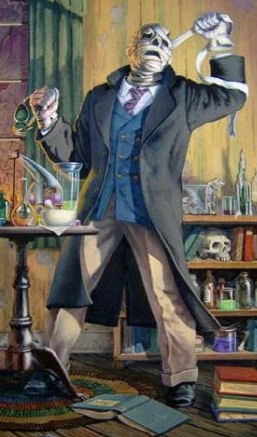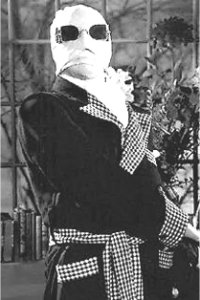 Real
Name: Griffin (no first name is given in the original story, but see
comments)
Real
Name: Griffin (no first name is given in the original story, but see
comments)
Identity/Class: Human mutate
Occupation: Scientist
Affiliations: Thomas Marvel
Enemies: Teddy Henfrey, Dr.Kemp, Bobby Jaffers, Colonel Adye
Known Relatives: Unnamed father
Aliases: The Voice, Invisible Man the First, the Unseen
Base of Operations: Sussex
First Appearance: The Invisible Man (novel, 1897)
Powers/Abilities: Permanently invisible, although this didn't extend to his clothing, so that if he wanted to make use of his abilities, he had to do so naked. Likewise any food ingested remains visible, at least until properly digested. He is also extremely strong, though it is unclear as to whether this is a side-effect of the invisibility process, or a result of his growing madness.
History: Born an albino, John Griffin was a scientist, a graduate of University College who had won a medal for chemistry. However he became fascinated by physics, and in particular light and optical density, and at the age of twenty-two he dropped medicine to concentrate on these new obsessions. He went to work for Professor Oliver at Chesilstowe College, a provincial establishment, all the while working at night on his theories. After six years he eventually figured a method which would allow him "to lower the refractive index of a substance, solid or liquid, to that of air" "without changing any other property of matter". He realised he could apply it to human tissue to turn the red colouring in blood white, without affecting its function - and since this would leave the only colouration in the body the skin pigmentation (which he personally lacked), he now had the means to become invisible. Deciding he could never finish his work with both his professor and students eating up his time, he moved to London and took up residence in Great Portland Street. After three more years his funds had run out, so he stole more money from his own father - but the money didn't belong to his parent, who shot himself in shame.
Believing his process finally perfected, Griffin tested it on a cat, turning all but its eyes transparent. Next he used the process on himself, and when his landlord proved too inquisitive, Griffin set fire to the house and fled into the night. Griffin swiftly his change was irreversible. Disguising his affliction with bandages, he moved to Iping, a small village in Sussex, where he took up residence in Mrs.Hall's boarding house. When money ran short, he used his powers to turn to burglary again, which attracted the attention of local police officer Mr.Bobby Jaffers. Confronted in the Coach and Horses public house, a scuffle ensued, during which his secret was uncovered (quite literally). Griffin fled into the night.
Naked and hunted, he enlisted the aid of tramp Mr.Thomas Marvel, who he sent to retrieve clothes and his notebooks. When some of the villagers attempted to detain Marvel, the Invisible Man displayed a violent side, coming to his ally's aid with an unmatched fury. Afterwards he berated Marvel, making it clear that if Marvel failed him again, or attempted to flee, then he would die. In spite of this dire warning, Marvel did eventually flee, realising the Invisible Man's psychosis was growing. The Invisible Man soon caught up with Marvel in the town of Port Burdock, and beat him within an inch of his life before witnesses intervened, one of whom managed to shoot Griffin, winging him.
The wounded Invisible Man stumbled into the house of Dr.Kemp, who by chance he knew as a fellow alumni of University College. He appealed to Kemp for aid, who acquiesced. However it soon became clear to Kemp that Griffin was becoming increasingly insane. He told Kemp of his origins, and his plan to use his invisibility to engage in a "Reign of Terror", using fear of his unseen approach and the threat of invisible murder to take control of a town of his choice. But Kemp had sent a message to Colonel Adye, the chief of the Burdock police, who arrived in time to save Kemp from murder at the hands of his guest. Kemp told Adye how to hunt his prey, with dogs and with powdered glass on the roads to cut his feet. Hunted and pursued, the fugitive apparently committed his first deliberate murder, slaying Mr. Wicksteed on the edge of a gravel pit.
Emboldened by this, Griffin sent a letter to Kemp, declaring himself the new ruler of the area, Invisible Man the First, and stating that he would make an example of Kemp by killing him to prove that none could stand against him. Even though the police immediately put Kemp under guard, the Invisible Man got passed them, murdering Adye with his own revolver in the process. Kemp fled the house, with Griffin in close pursuit. The tables turned when Kemp ran into a group of navvies, who managed to trap their unseen opponent, and beat him to death. With his demise, Griffin once again became visible.
 Comments: Created by H.G.Wells.
Comments: Created by H.G.Wells.
The Invisible Man described himself thus to Dr.Kemp, while attempting to jog his fellow student's memory - “Griffin,” answered the Voice—“a younger student, almost an albino, six feet high, and broad, with a pink and white face and red eyes—who won the medal for chemistry.”
H.G.Wells' Invisible Man has become one of the standard "monsters" of Hollywood, and inspired a slew of imitators. He first made it into film with the 1933, when Claude Rains played "Jack Griffin" in Universal Studios production of the book. In 1940 Vincent Price played the second Invisible Man, Geoffrey Radcliffe, in the sequel "The Invisible Man Returns". Radcliffe was turned invisible by "Frank Griffin", the heretofore unmentioned brother of the original scientist. 1951 saw the third in Universal's series, when detectives Bud Alexander and Lou Francis (comedians Abbot and Costello) give an invisibility injection to boxer Tommy Nelson (Arthur Franz) who has been wrongly accused of murder, "Abbot and Costello Meet The Invisible Man" (the comedy duo had briefly encountered the Vincent Price Invisible Man at the end of their 1948 feature, "Abbot and Costello Meet Frankenstein", when he made a cameo "appearance").
In 1984 the BBC made a six part serial adapting the story, with Pip Donaghy as Griffin. The same year a Russian adaption, "Chelovek-nevidimka", was also released. In 1998 it was Kyle MacLachlan's turn in the part (again given the full name Jack Griffin), in a U.S. TV movie version of Well's tale. There have also been innumerable other Invisible Men, inspired by this tale, but not directly connected to him (see the clarifications for some examples).
The character was recently revived as a member of Alan Moore's League of Extraordinary Gentlemen, and made it into the movie adaption of same. The comic version is the same Griffin from the novel, who faked his death by putting another through the process, then sending this unwitting dupe to meet the mob. The movie version is a thief who stole Griffin's formula.
In comics, Acclaim released "Classics Illustrated: The Invisible Man" in 1997, and in 2002 Moonstone Publishing released a sequel, "Legacy of the Invisible Man". Griffin was also name-checked in Dark Horse Comics' "Van Helsing: From Beneath the Rue Morgue", a tie-in with the Van Helsing movie, where the monster hunter discovers that Dr.Moreau has been experimenting on his beast men using Griffin's invisibility notes.
CLARIFICATIONS: He is meant to be the same character as
-
The Invisible Man of the League of Extraordinary Gentlemen
but should not to be confused with
-
Invisible Man, Daniel Westin
-
Invisible Man, Darien Fawkes
-
Gemini Man, invisible secret agent
-
The Hollow Man, another invisible scientist who went psychotic
-
any other many other "Invisible" people
Any Additions/Corrections? Please let me know.
All images and characters depicted on this site are copyright their respective holders, and are used for informational purposes only. No infringement is intended and copyrights remain at source.